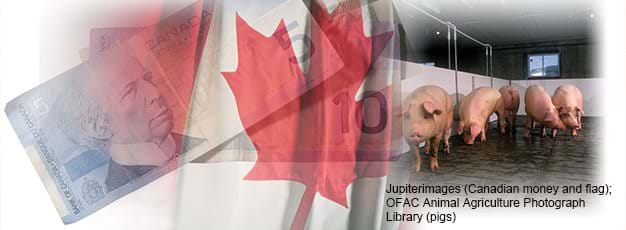Stronger Canadian Dollar Puts Pressure on Canada’s Pork Industry

The stronger Canadian dollar has led to a surge in U.S. exports to Canada and declining U.S. agricultural imports from Canada (see 'Canadian Dollar Reaches Parity With U.S. Dollar'). One exception, however, has been U.S.-Canadian trade in live swine. In the first 8 months of 2007, U.S. imports of live swine from Canada increased 11 percent over the same period in 2006.
The stronger Canadian dollar has made Canadian pork less competitive on international markets against products priced in depreciating currencies, such as the U.S. dollar. Because the Canadian pork industry annually exports over half of its pork production and about a quarter of its live pig crop, the increasing value of the Canadian dollar has been squeezing margins of Canadian slaughter plants and operations that export live animals for finishing in the United States.
The inability of the Canadian processing industry to compete against products of the highly efficient U.S. pork processing industry contributed to closures of slaughter plants in Québec, Saskatchewan, and Manitoba in 2007. Lower hog prices offered by remaining Canadian processors reduced incentives to finish young swine in Canada. Consequently, the southward flow of young swine to specialized finishing operations in the United States has increased (see 'Hog Operations Increasingly Large, More Specialized'). Growth in U.S. imports of slaughter hogs has been particularly strong, with imports in 2007 20 percent higher than in 2006.
Canadian swine prices are effectively set in the United States, and USDA forecasts lower hog prices into 2008. This trend will likely accelerate the downsizing already taking place in the Canadian pork industry. Statistics Canada has reported lower stocks of sows and bred gilts in every quarter since April 2005. Most breeding herd reductions, however, have occurred in Provinces with relatively low production. Larger, more efficient herds in Manitoba and Ontario have taken smaller cuts.
For 2008, USDA’s Foreign Agricultural Service is forecasting a fourth consecutive year of slowly decreasing pork production in Canada and a third consecutive year of small decreases in pork meat exports. However, exports of live finishing animals, as well as slaughter-ready hogs, to the U.S. will likely stay high. Large Canadian swine production operations will face fewer marketing alternatives as the Canadian processing industry continues to draw down slaughter capacity. The U.S. imported an estimated 9.6 million head of Canadian swine in 2007—68 percent were animals fed to maturity in the U.S. and 32 percent hogs meant for immediate slaughter. In 2008, imports are expected to total 9.7 million head, with roughly the same proportions of finishing and slaughter hogs.
Livestock, Dairy, and Poultry Outlook, Economic Research Service, August 2007
Foreign Agricultural Trade of the United States (FATUS), by Bart Kenner, James Kaufman, and Angelica Williams, USDA, Economic Research Service, June 2024
Hogs & Pork, by Mildred Haley, USDA, Economic Research Service, January 2024

